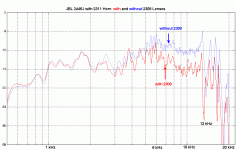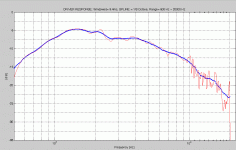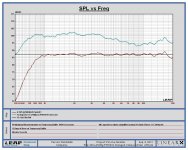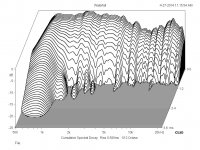Daniel,
Thanks for posting that paper, I have read this before and think I have it on my hard drive. What comes of that paper is that it take a much larger group of untrained listeners to come to a satisfactory averaged conclusion as related to the ranking of a loudspeaker. A small group could, not necessarily will give a skewed result. I would think that since this is true for a full range set of speakers playing music it would take a much larger group of untrained listeners if possible to rate a component difference by itself or a smaller group of trained listeners to make an accurate determination of a single component. I personally don't know how you could survey an untrained small group to identify critical differences between audio devices, it would appear that the knowledge to make this type of determination would be surely lacking in knowledge of critical components of sound reproduction. Group preferences would be something that would have to be understood, different age groups may have opposing views dominated by the current popular music listened to by that group coloring the responses. I think of the current young hip hop music listener who would also select a Beats headphone as the preferred device based on a preference for excess low bass with an unbalanced frequency response. There are so many details that must be learned and understood to make these types of accurate component selections that the use of a small group of untrained listeners could be very inaccurate.
Thanks for posting that paper, I have read this before and think I have it on my hard drive. What comes of that paper is that it take a much larger group of untrained listeners to come to a satisfactory averaged conclusion as related to the ranking of a loudspeaker. A small group could, not necessarily will give a skewed result. I would think that since this is true for a full range set of speakers playing music it would take a much larger group of untrained listeners if possible to rate a component difference by itself or a smaller group of trained listeners to make an accurate determination of a single component. I personally don't know how you could survey an untrained small group to identify critical differences between audio devices, it would appear that the knowledge to make this type of determination would be surely lacking in knowledge of critical components of sound reproduction. Group preferences would be something that would have to be understood, different age groups may have opposing views dominated by the current popular music listened to by that group coloring the responses. I think of the current young hip hop music listener who would also select a Beats headphone as the preferred device based on a preference for excess low bass with an unbalanced frequency response. There are so many details that must be learned and understood to make these types of accurate component selections that the use of a small group of untrained listeners could be very inaccurate.
I'm not a Ph.D. But in my field, what Dr. Geddes is saying makes perfect sense. Let me put it in the language of my field, the law.
Earl did a study, got x results, using a methodology was sound enough to survive the peer review process, and published his results in the publication of record. Through that process, he's established a rebuttable presumption that his results are correct. That presumption can certainly be rebutted by introducing evidence to the contrary. But to be strong enough to rebut the presumption, the new evidence needs to pass a similarly high threshold (blind listening, equalization to remove confounding FR differences, statistical analysis etc.) as the evidence that gave rise to the presumption in the first place. Thus far, that hasn't happened, so the presumption stands.
Thank you for that as it is absolutely correct and what I have been implying even if I was not so eloquent about it.
Using the correct test method, test results of beryllium as a material published elsewhere has proven to be a superior for compression driver diaphragms over titanium and aluminium. This is elementary physics if one cares to understand the break up modes of a compression driver diaphragm. Subjectively the matter has been proven beyond doubt to be the case.
Where were these subjective results published? How did I miss them?
I'm not a Ph.D. But in my field, what Dr. Geddes is saying makes perfect sense. Let me put it in the language of my field, the law.
Earl did a study, got x results, using a methodology was sound enough to survive the peer review process, and published his results in the publication of record. Through that process, he's established a rebuttable presumption that his results are correct. That presumption can certainly be rebutted by introducing evidence to the contrary. But to be strong enough to rebut the presumption, the new evidence needs to pass a similarly high threshold (blind listening, equalization to remove confounding FR differences, statistical analysis etc.) as the evidence that gave rise to the presumption in the first place. Thus far, that hasn't happened, so the presumption stands.
+1
There are so many details that must be learned and understood to make these types of accurate component selections that the use of a small group of untrained listeners could be very inaccurate.
That is why we used large groups of listeners. Sometimes they were experts, other times not, it depends. But suffice it to say, doing these kinds of tests is extremely difficult, which is why so few are ever done. And no matter how careful and well thought out the methodology there will always be uncertainty and there will always be someone who wants to throw out the entire study because of this uncertainty, no matter how insignificant it is.
Agreed that a quality peer reviewed scientific study in any field in not a simple task. We also have to understand that a current belief in a widely held assumption can create a predetermined outcome that is later found to be incorrect. It happens often enough that I would say it takes more than one study by one group to confirm many theoretical conclusions. We are still having disagreement by many whether phase shift over the entire frequency band is audible, there are many opposing conclusions and studies to back up both sides. Absolutes in audiology are hard to come by.
Study What? The Obvious!
The need to do that study, would require me to go deaf before the fact.
In that case, I would pick master musicians as auditors of each instrument I was reproducing in the listening tests. The variety of compression drivers used would be a lot more than three, so that usefull attributions of the differences between them could be made.
WHG
I'll wait for the results of your study. Until then I'll stick with those that I have.
The need to do that study, would require me to go deaf before the fact.
In that case, I would pick master musicians as auditors of each instrument I was reproducing in the listening tests. The variety of compression drivers used would be a lot more than three, so that usefull attributions of the differences between them could be made.
WHG
Last edited:
Testimony
So long as what I have heard in the acoustic lab is different than what EG is claiming, I will express dissention without obligation to conduct yet another study. Substantiating these facts in a courtroom would be a 'cake walk', as not only are the differences measurable, they are audible, and correlations between the two are well known. If this was not true, then work on compression driver design would have ceased a long time ago. It has not, and remains vigorously pursued by the audio industry. That observation is a matter of public record, not requiring a study to prove it. So, corporate behavior is either irrational or well founded. I suppose that many loudspeaker manufacturers could be ignoring their own self interest, by expending large sums of money on compression driver R & D for no good reason; but I doubt it. These observations should give rise to reasonable doubt in the minds of any peer jury, concerning the EG's claim (allegation).
Regards,
WHG
I'm not a Ph.D. But in my field, what Dr. Geddes is saying makes perfect sense. Let me put it in the language of my field, the law.
Earl did a study, got x results, using a methodology was sound enough to survive the peer review process, and published his results in the publication of record. Through that process, he's established a rebuttable presumption that his results are correct. That presumption can certainly be rebutted by introducing evidence to the contrary. But to be strong enough to rebut the presumption, the new evidence needs to pass a similarly high threshold (blind listening, equalization to remove confounding FR differences, statistical analysis etc.) as the evidence that gave rise to the presumption in the first place. Thus far, that hasn't happened, so the presumption stands.
So long as what I have heard in the acoustic lab is different than what EG is claiming, I will express dissention without obligation to conduct yet another study. Substantiating these facts in a courtroom would be a 'cake walk', as not only are the differences measurable, they are audible, and correlations between the two are well known. If this was not true, then work on compression driver design would have ceased a long time ago. It has not, and remains vigorously pursued by the audio industry. That observation is a matter of public record, not requiring a study to prove it. So, corporate behavior is either irrational or well founded. I suppose that many loudspeaker manufacturers could be ignoring their own self interest, by expending large sums of money on compression driver R & D for no good reason; but I doubt it. These observations should give rise to reasonable doubt in the minds of any peer jury, concerning the EG's claim (allegation).
Regards,
WHG
Thanks
Will read and comment later.
Regards,
WHG
Trained vs. untrained listeners:
http://www.aes.org/tmpFiles/elib/20140607/12206.pdf
Will read and comment later.
Regards,
WHG
Hi Kindhornman,
I think the way lenses are working is very simple. If You are looking at them it is easy to see that some part of the sound (front) has to pass LONGER path. As the angle of the lenses plate is about 40 degree (in vertical plane), so the longest sound path is about 40% MORE the central part, so everything behave as some part of the sound "front" would pass LOWER SPEED media (here the speed is equal, but the way length differs), but almost without loss. Owing to the hyperbolic "V" shape of the lenses plates, a kind of acoustic lens can be get.
Regards
ivica
Some measurements 2446 with 2311 with and without 2308 lenses
Attachments
Hi POS,
It would be , for me , more interesting if measurements can be done with PT-H95HF horn, but.....
I would expect that LF loading (under 2kHz) for D2430K would be better, but have no idea about HF response, may be a kind of HF cancellation can be get, and so no so good HF response would be.
regards
ivica
some measurements 2450SL driver with PT-H95HF horn
Attachments
...I have done several tests on the subjective audibility of differences like this and they have all concluded that differences like this are not audible...
Just reread your paper on subjective tests of compression drivers. Nice that someone has done more than just speculate.
Could I just confirm a few points?
The three levels were 14 V, 20 V and 28 V.
So for the 8 ohm nominal drivers this would be very close to 25 W, 50 W and 100 W.
The article does not specify the particular drivers but the JBL 2450 meets the specifications of 8 ohm nominal, Titanium dome on 4" Aluminium ribbon VC, 2" exit, 4 annular slit phase p. NeFeB, so should be representative.
On a 2" Plane Wave Tube the 28V input will produce about 162 dB SPL if I read the JBL specification sheet correctly.
So the comparisons were done between approximately 162 dB, 159 dB and 156 dB at the throat? Of course this depends a little on thermal compression and the test conditions are not specified sufficiently to estimate this.
But is that a reasonable estimate of the order?
Best wishes
David
Last edited:
Dave
I did the subjective tests, not create the actual test samples so I know some of the answers but not all of them. I did not know the drivers being used and still do not know what drivers were used.
I know that B&C had trouble with the high SPL levels, but if I recall accurately they were more in the 110-125 dB range than the numbers that you quote. I do not think that the dB numbers that you quote would even be possible.
I did the subjective tests, not create the actual test samples so I know some of the answers but not all of them. I did not know the drivers being used and still do not know what drivers were used.
I know that B&C had trouble with the high SPL levels, but if I recall accurately they were more in the 110-125 dB range than the numbers that you quote. I do not think that the dB numbers that you quote would even be possible.
Not that I would know, but I am having a hard time imagining where, upon completely accepting Earl's study and conclusions, a corporation would see an opportunity to save lots of money on R&D by accepting some relatively high harmonic distortion level as good enough. They've still customers that want more output, more bandwidth, smooth response w/ less fuss, etc., right?So, corporate behavior is either irrational or well founded. I suppose that many loudspeaker manufacturers could be ignoring their own self interest, by expending large sums of money on compression driver R & D for no good reason; but I doubt it.
Dumptruck,
Since the major component of distortion in any audio system is by more than a factor higher than anywhere else in the reproduction chain caused by the speakers system, whether dome tweeters or compression drivers and direct radiators anyone who thinks that the challenges are done with these components is just whistling in the wind! Yes by far compression drivers have some of the lowest inherent distortion products that does not mean there are no improvements to be had. It would be nice to see a compression driver with extended high frequency response and a smooth frequency response across the entire useable response range. I know some don't think it worth the effort to get a compression driver to have response above 16Khz but I am not in that camp. Most drivers start rolling down at about 13Khz and are done by 16Khz with plenty of perturbations. You will see efforts on compression drivers for years to come.
Since the major component of distortion in any audio system is by more than a factor higher than anywhere else in the reproduction chain caused by the speakers system, whether dome tweeters or compression drivers and direct radiators anyone who thinks that the challenges are done with these components is just whistling in the wind! Yes by far compression drivers have some of the lowest inherent distortion products that does not mean there are no improvements to be had. It would be nice to see a compression driver with extended high frequency response and a smooth frequency response across the entire useable response range. I know some don't think it worth the effort to get a compression driver to have response above 16Khz but I am not in that camp. Most drivers start rolling down at about 13Khz and are done by 16Khz with plenty of perturbations. You will see efforts on compression drivers for years to come.
The market for compression drivers is very large and the sales will go to that company who are perceived to be "leading the pack" whether or not what they are doing makes any real sense.
Consider this: Floyd Toole and Sean Olive both believe that non-linear distortion is irrelevant and yet there very own company makes a big deal out of it. If this is not marketing, then what is it?
Consider this: Floyd Toole and Sean Olive both believe that non-linear distortion is irrelevant and yet there very own company makes a big deal out of it. If this is not marketing, then what is it?
Earl,
I think you would have to make the argument then that lowering distortion was irrelevant whether linear or not.
I think you would have to make the argument then that lowering distortion was irrelevant whether linear or not.
Hello Kindhornman
Take a look at this, it's a JBL 476Mg on a 100x100 waveguide raw and with a simulated network. Looks real promissing can't wait to actually hear what it sounds like.
Rob🙂
It would be nice to see a compression driver with extended high frequency response and a smooth frequency response across the entire useable response range. I know some don't think it worth the effort to get a compression driver to have response above 16Khz but I am not in that camp. Most drivers start rolling down at about 13Khz and are done by 16Khz with plenty of perturbations. You will see efforts on compression drivers for years to come.
Take a look at this, it's a JBL 476Mg on a 100x100 waveguide raw and with a simulated network. Looks real promissing can't wait to actually hear what it sounds like.
Rob🙂
Attachments
Last edited:
I did the subjective tests, not create the actual test samples so I know some of the answers but not all of them. I did not know the drivers being used and still do not know what drivers were used.
No problem. I used the JBL as representative.
B&C and Beyma both have equivalent drivers, the DE1050Nd and CP850Nd respectively, with essentially similar parameters.
Just that the JBL is the only one with PWTube data.
I know that B&C had trouble with the high SPL levels, but if I recall accurately they were more in the 110-125 dB range than the numbers that you quote. I do not think that the dB numbers that you quote would even be possible.
For a plausibility check I did the Beyma numbers too.
They quote 112 dB @ 2.8 V @ 1 m on a typical horn.
So 132 dB @ 28 V @ 1 m.
SPL at the 50 mm diameter throat will be about proportional to area ratio, assume 1 steradian for the horn.
(1000 mm / 50 mm) ^ 2 adds another 26 dB.
= 158 dB at the throat, comparable to the JBL data on a 50 mm tube.
So it seems the levels are quite possible, but extreme.
Even the minimum level is rather extreme, I am not surprised B&C had trouble with the SPL levels.
I am surprised there was no baseline at a more typical domestic level.
Best wishes
David
Last edited:
I am surprised there was no baseline at a more typical domestic level.
Best wishes
David
Yes, that was a mistake in the test design.
- Home
- Loudspeakers
- Multi-Way
- Geddes on Waveguides



